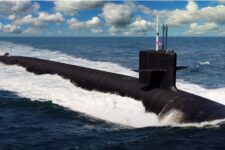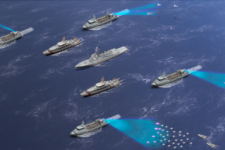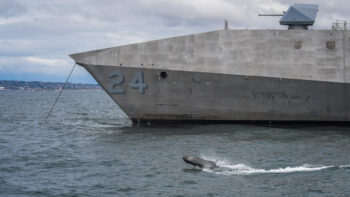
USS Gerald R. Ford conducts high-speed turns in the Atlantic Oct. 27.
CAPITOL HILL: Navy and Marine Corps leaders were blindsided by recent cuts to shipbuilding accounts and money ripped from their budgets to fund the Trump administration’s border wall, service leaders told lawmakers today.
In some of the most frank exchanges military officials have had over the budget demands imposed on them by Defense Secretary Mark Esper and the White House, Navy leaders painted a picture of a budget process where they were told, often after the fact, that they were losing ships and billions in funding.
Chief of Naval Operations Adm. Michael Gilday told the House Armed Services Committee this morning the $4 billion reduction in his shipbuilding account from last year’s budget “happened at budget endgame very quickly,” adding that Navy officials “were informed after the decision was made.”
Some of the cuts — particularly of a planned Virginia-class submarine — were made so the Pentagon would fund an increase at the National Nuclear Security Administration, which received a 20 percent boost in funding to $19.8 billion under the 2021 request.
Also, the Trump administration stripped $3.8 billion earlier this month from Pentagon procurement and construction accounts to help fund the administration’s border wall, a culling that included a $650 million America-class amphibious assault ship, a $261 million Expeditionary Fast Transport ship, along with F-35s and P-8 surveillance planes.
Requests sent to Pentagon spokespeople to confirm the Navy’s account were not returned.
HASC Chairman Rep. Adam Smith asked how the reductions affect plans to build a 355-ship fleet, a central defense pledge of President Trump’s. “To be frank, it’s not helpful because it takes a ship out of a plan that we’re driving towards,” Acting Navy Secretary Thomas Modly told the committee. “It particularly is harmful in the sense that it takes a ship out of a category of ship for which we’re going to have a hard time getting to anyway.”
The Navy was aware the Pentagon was “looking at a variety of different options,” Modly said, “and then, at the end, those options were presented to us.”
The losses, which the Pentagon says are temporary and can be restored in future budgets, have created an aura of uncertainty, as the White House has created a precedent where the president can declare a national emergency and then bypass Congress by dipping into Pentagon accounts. The Constitution is clear that only Congress may pass spending bills and provide funds for the common defense and maintenance of the militia.
Chairman of the Joint Chiefs Gen. Mark Milley told the same committee Wednesday that the $3.8 billion pulled from DoD budget doesn’t have a “significant, immediate, strategic, negative impact to the overall defense,” an argument that would seem to call into question the department’s yearly plea for more money.
Shrinking To Grow
As part of their overall modernization plans, the Navy and Marine Corps had been planning for some time to retire older ships and weapons systems in order to invest in newer, more deadly systems. It’s part of a ‘shrink to grow’ strategy in an era where budgets are expected to be flat, and aging planes, ships, and vehicles cost more and more to maintain.
“We need a Navy that is lethal more than we need a bigger Navy that is less lethal,” Gilday told lawmakers, nodding to the need to keep current ships at sea while developing new precision weapons, lasers and networking capabilities, as opposed to simply putting a lot of new hulls in the water.
Marine Commandant Gen. David Berger said “this year is the pivot” budget that allows the Corps to shed old gear to make room for modernized equipment. The Corps will shed about 2,000 Marines in 2021, and “in ‘22 and ‘23 it will be significantly more,” he cautioned. “We reduced the end strength by a few thousand Marines, and that probably won’t be the last” cut.
Today’s HASC meeting was markedly less heated than Wednesday’s dustup between Defense Secretary Mark Esper and lawmakers, where he bore the brunt of show of bipartisan unity in opposing the cuts to the Navy. This morning, military leaders promised big changes in the size and structure of the fleet of the future in a message that was both nuanced and realistic..
The 30-year shipbuilding plan, the Integrated Force Structure Assessment, and a new Marine Corps force structure plan — all of which were expected to be released this month — are on hold as Deputy Defense Secretary David Norquist conducts a series of war games to chart a path forward. Esper on Wednesday told lawmakers he pulled the strategy development out of the hands of the Navy after reviewing them and found them lacking.
Modly said he expects the Navy’s plans to be wrapped up in several months, a timeline backed up by a defense official who told me to expect it to be “months” before the process plays out.
Even as the services lose some control over their force planning, they’re still making plans. Modly estimated today that the Navy needs $120 or $130 billion more over the next 10 years to build a 355-ship fleet, a four year-old requirement that the service appears to be sticking with, until the Pentagon leadership tells them differently.
As Modly noted, the bill is huge, and the Navy still has a readiness hole to dig out of while it tries to grow.
A full 63 percent of ships still can’t leave the dock on time after repair, something leadership wants to slash by 2021. There are also big new investments in hypersonic weapons, a new class of frigates and unmanned vehicles on the horizon. But all of that pales in comparison with the bill coming due for the new class of Columbia submarines, which will carry the Navy’s contribution to the nation’s nuclear triad.
The Columbia will eat up a whopping 31 percent of the Navy’s entire shipbuilding budget in coming years as the service starts building the 12 boats it currently plans for, a bite that will either require more money, or a new way of thinking about how it structures the fleet.
But service leaders tried to put a positive spin on all the churn and uncertainty. “The size of the fleet is growing — it’s just not growing at the pace some would prefer,” Modly said.
After chilly silence, US SecDef, China defense minister hold first talks
Having regular mil-to-mil talks with China “is an important priority for us,” a senior defense official said, pointing to the PRC’s behavior in the South China Sea, as well as the importance of “peace and stability across the Taiwan Strait.”


























